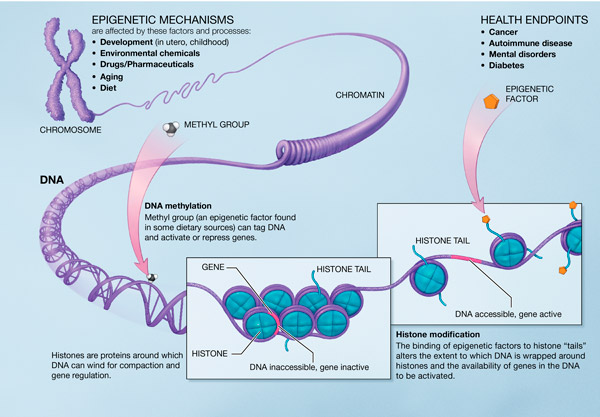Does this epigenetic chemical in the brain help create the brain’s complexity?
September 18, 2012
Researchers from the Centre for Addiction and Mental Health (CAMH) in Toronto have identified a new role of a chemical involved in controlling the genes underlying memory and learning.
“The brain is a plastic tissue, and we know that learning and memory require various genes to be expressed,” says CAMH Senior Scientist Dr. Art Petronis, a senior author on the new study.
“Our research has identified how the chemical 5-hmC [5-hydroxymethylcytosine] may be involved in the epigenetic processes allowing this plasticity.” Dr. Petronis is head of the Krembil Family Epigenetics Laboratory in CAMH’s Campbell Family Mental Health Research Institute.
Turning genes in brian cells on and off
5-hmC is an epigenetic [things other than genes] modification of DNA that was discovered in humans and mice in 2009. Epigenetic DNA modifications flag specific genes to be turned “on” — signalling the genome to make a protein — or turned “off.” Since the overwhelming majority of cells in an individual contain the same genetic code, this pattern of flags is what allows a neuron to use the same genome as a blood or liver cell, but create a completely different and specialized cellular environment.
The research sheds light on the role of 5-hmC. Intriguingly, it is more abundant in the brain than in other tissues in the body, for reasons not clear to date.
The CAMH team of scientists examined DNA from a variety of tissues, including the mouse and human brain, and looked at where 5-hmC was found in the genome. They detected that 5-hmC had a unique distribution in the brain: it was highly enriched in genes related to the synapse, the dynamic tips of brain cells. Growth and change in the synapse allow different brain cells to “wire” together, which enables learning and memory.
Master controller for learning and memory?
“This enrichment of 5-hmC in synapse-related genes suggests a role for this epigenetic modification in learning and memory,” says Dr. Petronis.
The team further showed that 5-hmC had a special distribution within the gene. The code for one gene may be edited and “spliced” in brain cells to create several different proteins. Dr. Petronis found that 5-hmC is located at “splice junctions,” the points where the gene is cut before splicing.
“5-hmC may signal the cell’s splicing machinery to generate the diverse proteins that, in turn, give rise to the unprecedented complexity of the brain,” he says.
The research team is continuing to investigate the role of 5-hmC in more detail, and to determine whether 5-hmC function is different in people with bipolar disorder and schizophrenia compared to people without these diagnoses.
This research was funded by the U.S National Institutes of Health, the Canadian Institutes of Health Research, and the Tapscott Chair in Schizophrenia Studies at the University of Toronto.

